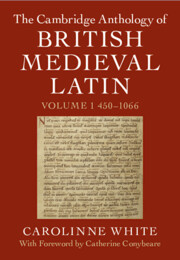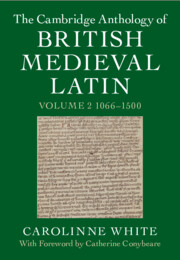118 results
32 - Scripts
- from Part 5 - Sociolinguistic and Geographical Approaches
-
-
- Book:
- The Cambridge Handbook of Slavic Linguistics
- Published online:
- 16 May 2024
- Print publication:
- 23 May 2024, pp 675-696
-
- Chapter
- Export citation
A survey involving secondary students with dyslexia studying Latin or a modern foreign language
-
- Journal:
- Journal of Classics Teaching , First View
- Published online by Cambridge University Press:
- 27 February 2024, pp. 1-7
-
- Article
-
- You have access
- Open access
- HTML
- Export citation
Classical Studies Trends: teaching Classics in secondary schools in the UK
-
- Journal:
- Journal of Classics Teaching , First View
- Published online by Cambridge University Press:
- 22 February 2024, pp. 1-17
-
- Article
-
- You have access
- Open access
- HTML
- Export citation
Rewriting the Textbook: an investigation into students’ practices with creative composition in a Year 7 Latin class
-
- Journal:
- Journal of Classics Teaching , First View
- Published online by Cambridge University Press:
- 22 February 2024, pp. 1-6
-
- Article
-
- You have access
- Open access
- HTML
- Export citation
Envoi
-
-
- Book:
- The Cambridge Critical Guide to Latin Literature
- Published online:
- 04 January 2024
- Print publication:
- 18 January 2024, pp 907-916
-
- Chapter
- Export citation
Chapter 8 - Layout, Script and Language of the Ordo Romanus Manuscripts
- from Part III - Format and Script of the Manuscripts
-
- Book:
- Roman Liturgy and Frankish Creativity
- Published online:
- 04 January 2024
- Print publication:
- 18 January 2024, pp 207-235
-
- Chapter
- Export citation
Chapter 3 - Periodisations
-
-
- Book:
- The Cambridge Critical Guide to Latin Literature
- Published online:
- 04 January 2024
- Print publication:
- 18 January 2024, pp 97-157
-
- Chapter
- Export citation

The Cambridge Anthology of British Medieval Latin
-
- Published online:
- 11 January 2024
- Print publication:
- 01 February 2024

The Cambridge Anthology of British Medieval Latin
-
- Published online:
- 11 January 2024
- Print publication:
- 01 February 2024
The Mustis arch and its dedication
-
- Journal:
- Libyan Studies , First View
- Published online by Cambridge University Press:
- 08 January 2024, pp. 1-8
-
- Article
- Export citation
EMENDATIONES TIBVLLIANAE I
-
- Journal:
- The Classical Quarterly / Volume 73 / Issue 2 / December 2023
- Published online by Cambridge University Press:
- 26 February 2024, pp. 721-728
- Print publication:
- December 2023
-
- Article
-
- You have access
- Open access
- HTML
- Export citation
Steps towards inclusivity: modifying challenging content, navigating pedagogical materials and initiating student reflection within the Classics classroom
-
- Journal:
- Journal of Classics Teaching / Volume 25 / Issue 49 / Spring 2024
- Published online by Cambridge University Press:
- 29 November 2023, pp. 4-7
-
- Article
-
- You have access
- Open access
- HTML
- Export citation
43rd JACT Latin Summer School – 2023 Director's Report
-
- Journal:
- Journal of Classics Teaching / Volume 25 / Issue 49 / Spring 2024
- Published online by Cambridge University Press:
- 03 November 2023, pp. 72-76
-
- Article
-
- You have access
- Open access
- HTML
- Export citation
12 - Situating Latinx Immigrant Romantic Relationships in the Context of Illegality
-
-
- Book:
- The Sociocultural Context of Romantic Relationships
- Published online:
- 19 October 2023
- Print publication:
- 02 November 2023, pp 226-246
-
- Chapter
- Export citation
Medieval Mediterranean Pharmacology
-
-
- Book:
- Drugs in the Medieval Mediterranean
- Published online:
- 19 October 2023
- Print publication:
- 02 November 2023, pp 1-34
-
- Chapter
- Export citation
Chapter 2 - “The tears stand in my eyes”
- from Part I - Johnson’s Criticism and the Forms of Feeling
-
- Book:
- The Literary Criticism of Samuel Johnson
- Published online:
- 07 September 2023
- Print publication:
- 21 September 2023, pp 34-52
-
- Chapter
- Export citation
A Scato-sexual Message: The Secundinus Stone with Phallus from Vindolanda
-
- Article
-
- You have access
- Open access
- HTML
- Export citation
Latin and Greek in English Primary Schools – seedlings of a classical education
-
- Journal:
- Journal of Classics Teaching / Volume 25 / Issue 49 / Spring 2024
- Published online by Cambridge University Press:
- 29 August 2023, pp. 60-64
-
- Article
-
- You have access
- Open access
- HTML
- Export citation
8 - When the Endogenous Becomes Exogenous
-
- Book:
- Shocking Contrasts
- Published online:
- 09 June 2023
- Print publication:
- 17 August 2023, pp 187-207
-
- Chapter
- Export citation



